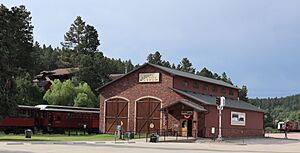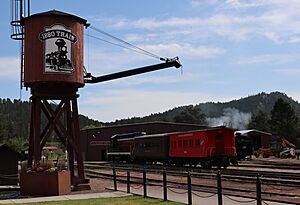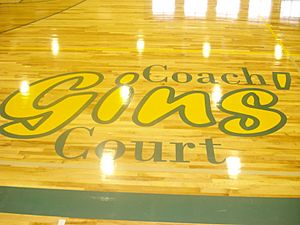Hill City, South Dakota facts for kids
Quick facts for kids
Hill City
|
|
|---|---|
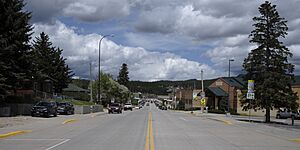 |
|
| Motto(s):
The Heart of the Hills
|
|
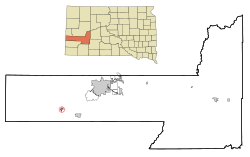
Location in Pennington County and the state of South Dakota
|
|
| Country | United States |
| State | South Dakota |
| County | Pennington |
| Established | 1876 |
| Incorporated | 1945 |
| Government | |
| • Type | Mayor-Council |
| Area | |
| • Total | 1.32 sq mi (3.42 km2) |
| • Land | 1.31 sq mi (3.40 km2) |
| • Water | 0.01 sq mi (0.02 km2) |
| Elevation | 5,013 ft (1,528 m) |
| Population
(2020)
|
|
| • Total | 872 |
| • Density | 664.63/sq mi (256.63/km2) |
| Time zone | UTC−7 (MST) |
| • Summer (DST) | UTC−6 (MDT) |
| Zip Code |
57745
|
| Area code(s) | 605, NXX Exchange 574 |
| FIPS code | 46-29100 |
| GNIS feature ID | 1267423 |
| Website | City of Hill City |
Hill City is a historic town in Pennington County, South Dakota, USA. It is the oldest city still existing in the county. In 2020, about 872 people lived there. Hill City is located about 26 miles (42 km) southwest of Rapid City. It sits on U.S. Highway 16 and U.S. Route 385. These highways connect towns like Deadwood and Hot Springs.
Hill City is often called the "Heart of the Hills." This name comes from its central location in the Black Hills. It is also close to many popular tourist spots. The town began during the Black Hills mining rush in the late 1800s. At first, tin mining was very important. Over time, tourism and timber became the main industries. Famous places like Mount Rushmore and Custer State Park helped make the Black Hills a popular tourist spot. Hill City has also become a hub for art, with many studios and festivals.
Contents
History of Hill City: From Mining to Tourism
The area around Hill City has a long human history. People lived here as early as 7000 BC. Native American tribes like the Arikara and Lakota Sioux lived here. The Lakota called the land Paha Sapa, meaning Black Hills.
In 1874, gold was found in French Creek, near where Hill City is now. This discovery brought many miners to the Black Hills. Hill City was first settled by miners in 1876. They called the area "Hillyo." It was the second American settlement in the Black Hills. A post office opened in 1877. The town almost became a ghost town when miners moved north to find more gold.
Tin Mining and a Wild West Town
In 1883, tin was discovered near Hill City. This brought people back to the town. The Harney Peak Tin Mining, Milling, and Manufacturing Company set up its main office here. This company was supported by English investors. They bought many mining sites in the area.
As mining grew, Hill City became known for its lively atmosphere. People even called it "a town with a church on each end and a mile of Hell in between." At one point, there were 15 saloons on Main Street. The company built the Harney Peak Hotel for its leaders. The tin market did not last, and the company closed in 1902.
Schools and Firefighters
A small school was built early on. A larger main school building was constructed in 1921. This building was replaced by the current high school in 2001.
In 1939, a big fire started near Hill City. The entire high school basketball team helped fight the fire. The United States Forest Service praised them for their efforts. Because of this, the school team became known as the Hill City Rangers. They are the only school in the U.S. allowed to use Smokey Bear as their official mascot. Hill City officially became a city on March 21, 1945.
The Harney Peak Hotel operated until 1934. It has been restored and is now the Alpine Inn. This building is on the List of Registered Historic Places in South Dakota.
Dinosaurs and Movies
The Black Hills Institute of Geological Research opened in 1973. This institute studies and displays dinosaur and other fossils. In 1992, they were involved in a legal case about the ownership of a Tyrannosaurus rex fossil named "Sue". Hill City was also a filming location for the 1994 movie Lakota Woman: Siege at Wounded Knee.
Railroad History and the 1880 Train
Two main railroad lines crossed through Hill City. One was the Burlington Northern Line, also called the High Line. The other was the Black Hills Central Line, which went from Hill City to Keystone. The High Line reached Hill City in 1893. The Black Hills Central Line reached Keystone in 1900.
The High Line stopped passenger service in 1949 and closed completely in 1983. It is now the George S. Mickelson Trail, a popular bike trail.
In 1957, the Black Hills Central Railroad started a tourist train called the 1880 Train. It runs on the Black Hills Central Line. A flood in 1972 damaged part of the line, but it was fixed in 2001. The Black Hills Central Railroad restores old locomotives and train cars. Their trains have appeared in TV shows like Gunsmoke and movies like Orphan Train.
Geography and Climate of Hill City
Hill City is located in the Black Hills. It is near the geographic center of the Black Hills. This is why its motto is "The Heart of the Hills." Spring Creek and Newton Fork flow through the east side of town.
The city covers about 1.27 square miles (3.29 km²). Most of this area is land, with a small amount of water.
The climate in Hill City is generally dry. It gets about 20 inches (508 mm) of rain each year. The surrounding hills help keep the weather cooler in both winter and summer. They also make the town calmer, with less wind than areas outside the Black Hills. Hill City has a climate type called Dwb. This means it has warm summers but dry winters. This type of climate is rare in non-tropical parts of the United States.
Population and People
| Historical population | |||
|---|---|---|---|
| Census | Pop. | %± | |
| 1890 | 470 | — | |
| 1910 | 271 | — | |
| 1950 | 361 | — | |
| 1960 | 419 | 16.1% | |
| 1970 | 389 | −7.2% | |
| 1980 | 535 | 37.5% | |
| 1990 | 650 | 21.5% | |
| 2000 | 780 | 20.0% | |
| 2010 | 948 | 21.5% | |
| 2020 | 872 | −8.0% | |
| U.S. Decennial Census | |||
In 2010, there were 1008 people living in Hill City. The population density was about 752 people per square mile (290 per km²). The town had 394 households.
Most residents were White (82.1%). There were also Native American (4.0%) and African American (0.6%) residents. About 18.9% of the population was Hispanic or Latino.
About 33% of households had children under 18. The average age in Hill City was 37.9 years. About 25.8% of residents were under 18.
Economy: Timber, Tourism, and Art
Hill City's economy relies on three main industries: timber, tourism, and telecommunications.
The timber industry is important because Hill City is located in the Black Hills National Forest. A large lumber mill, Rushmore Forest Products, used to be the biggest employer. It closed in 2021.
Tourism thrives due to Hill City's closeness to famous landmarks. These include Mount Rushmore, Crazy Horse Memorial, Custer State Park, and the Sturgis Motorcycle Rally. The town has many attractions, restaurants, souvenir shops, and art galleries for visitors. RMA & Associates, a company that does telephone surveys, also has a call center in Hill City.
Hill City is becoming known as the arts center of the Black Hills. It has several art galleries and studios. These include Warrior's Work gallery, which shows Native American and Western art, and Black Hills Bronze. The town is also home to Art of the Hills magazine.
Hill City collects a 2% sales tax on most goods. There is an extra 1% tax on lodging, restaurants, alcohol, and ticket sales. Hill City does not tax income for businesses or individuals.
Education in Hill City
The Hill City School District 51-2 serves the area. It has elementary, middle, and high schools. All three schools are on the same campus but in separate buildings. The original school building was built in 1921. An elementary school was added in 1961, and a middle school in the 1970s. A new high school was completed in 2002.
The schools are mainly funded by property taxes from people living in the district. The district also allows students from other areas to enroll. In the 2010–2011 school year, 506 students were enrolled. Many students live outside the city limits. The school district also serves the town of Keystone and the smaller towns of Rochford and Silver City.
Culture and Community Life
Hill City is a growing hub for the visual arts in the Black Hills. The Hill City Arts Council promotes art events throughout the year. These include the annual Art Extravaganza and an Arts and Crafts fair. There are also annual quilt shows. The town has seven art studios and galleries. They feature sculptures, watercolors, paintings, and Native American artwork and jewelry.
The Hill City Slickers are a local music group. They play country, folk, and bluegrass music. They have released three albums.
Hill City is home to the Black Hills Museum of Natural History. This museum displays dinosaurs, fossils, gemstones, and meteorites. A highlight is "Stan", a Tyrannosaurus rex skeleton. The museum also hosts Natural History Days, an event with speakers and a fossil hunt for children.
Wade's Gold Mill and Mining Museum shows the history of mining in the Black Hills. It has old mining equipment and a gold mill.
Many different faiths are present in Hill City. Five church buildings are located in town. These include Assemblies of God, Catholic Church, Lutheran Church–Missouri Synod, Evangelical Lutheran Church in America, and a non-denominational Christian church.
Sports and Outdoor Activities
Hill City High School is part of the South Dakota High School Activities Association. It competes in class "A" sports. As mentioned earlier, the school's mascot is Smokey Bear. This is because students helped fight a wildfire in 1939. Their fight song is the Marines' Hymn.
High school boys play basketball, football, track and field, cross country, and wrestling. High school girls compete in basketball, volleyball, cheerleading, track and field, cross country, and golf. The school also has a choir, band, and theater department.
Outdoor sports are very popular in the Hill City area. These include hiking, mountain climbing, snowmobiling, and dogsled racing. Hill City is a trailhead for the George S. Mickelson Trail. This trail runs from Deadwood to Edgemont. It is used for running, cycling, and snowmobiling in winter.
Snowmobiling is a big activity, with 350 miles (563 km) of groomed trails. Some snowmobiling magazines have called the Black Hills one of the best places to ride in North America.
Notable People from Hill City
- Frank Henderson, a judge and state politician.
- Jonathan Karl, an ABC News Washington Correspondent who grew up in Hill City.
- Watson Parker, a historian who specialized in the history of the Black Hills. He grew up on a ranch near Hill City.
Local Media
Television and radio stations in Hill City are mostly from the Rapid City area. Hill City has one local FM station, 103.9 K280AJ.
- Television
- FM Radio
- 89.3 KBHE SDPB/NPR
- 92.3 KQRQ-FM "Q 92.3"
- 93.1/99.5 KRCS "Hot 93.1"
- 93.9 KKMK "Magic 93.9"
- 95.1 KSQY "K-Sky"
- 97.9/105.7 KVPC "VCY America"
- 98.7 KOUT "Kat Country"
- 100.3 KFXS "The Fox"
- 103.9 K280AJ
- 104.1 KIQK "Kick 104"
- 106.3 KZLK "Max FM"
- AM Radio
- 810 KBHB Sturgis
- 920 KKLS Rapid City
- 980 KDSJ Deadwood
- 1150 KIMM Rapid City
- 1340 KTOQ Rapid City
- 1380 KOTA Rapid City
The Hill City Prevailer is a weekly newspaper. It covers local news in Hill City and Keystone. It was started in 1970.
Art of the Hills Magazine is published twice a year. It focuses on visual and performing arts and creative writing in the Black Hills.
See also
 In Spanish: Hill City (Dakota del Sur) para niños
In Spanish: Hill City (Dakota del Sur) para niños


